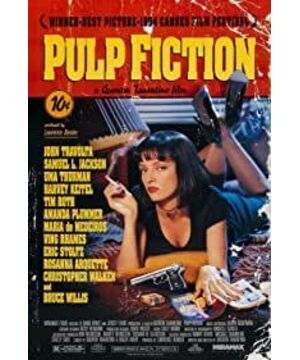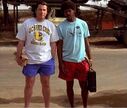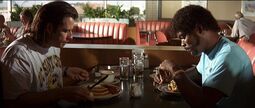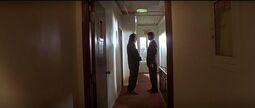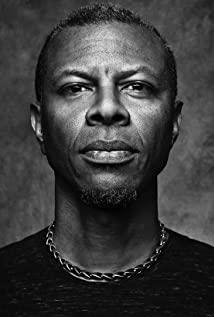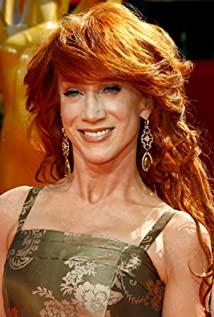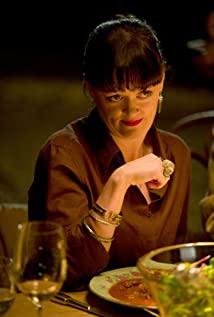In the 1990s, at the peak of film history, he won the 67th Academy Awards in 1995, the Palme d'Or at the 47th Cannes International Film Festival in 1994, and the Best Screenplay (original screenplay) award 3 times. The total number of awards is as high as 34 times, the "Pulp Fiction" directed by Quentin Tarantino, a ruffian who has been pushed to the altar by many movie lovers, is so good in the end?
Different from the traditional linear narrative structure, the film itself divides the plot into three stories: Vincent and Marsha's wife, Gold Watch, and the situation of Bonnie. But in fact the whole movie can be subdivided into several small incidents, a couple robbers rob a restaurant; Vincent and Jules help the boss Marsha kill; Marsha's lover Mia nearly died of drug addiction; boxer Butch And the gold watch; Vincent went head-to-head with the informant, etc. It is worth mentioning that all the stories told in the film happened on the same day. If you just look at each storyline, it is full of unexpected nonsense and sudden accidents, covered with nonsense and vulgar taste, watching the movie. The filmmakers may resonate because it tells about the daily life, the life, the daily life of each of us, which may be static or changeable. These daily lives are vulgar and resonant because they are daily life. Together, it is a piece of pulp fiction. Having said so much, I will subdivide several sections for in-depth analysis and side-by-side comparison of the beauty of this movie.
Shots : Quentin's films are full of character dialogues, and there's no better way to present them than with masterful use of shots. For example, at the beginning of the film, a couple plans to rob a restaurant and spends a full 4 minutes explaining their plan. I've always believed that the camera lens can echo the lines very well, and this paragraph can confirm this point of view. The couple used two types of shots in their conversation. Professionally, they are called external reverse shots (also known as over-the-shoulder shots) and internal reverse shots (also known as single shots). Generally speaking, when the camera focuses on one of them When the other person's shoulder, back of head, etc. were photographed, the other person did not appear in the camera. Although these two shots look the same, they are quite different in audiovisual language. The single shot of the inside reverse shot mainly shows the audience what the actor said; the over-the-shoulder shot of the outside reverse shot shows what one person told the other. In general, Quentin used two kinds of shots to grasp the instantaneous relationship between the two characters, which were very in line with the relationship between the characters at that time, which can be collectively referred to as relationship shots. Take an example. In the first picture, the male robber recalled to the female robber the accident that happened in the bank robbery. It was a dialogue when they discussed the plan. In this picture, the two of them are connected, which is a good time to use the over-the-shoulder lens. Looking at the second picture, the boy said, "No one has robbed the restaurant, why not?" During this period of time, he has also been explaining his idea of wanting to rob the restaurant. The female robber had no direct connection at this moment, so a single shot was used to more clearly highlight the image of the male robber and his expression at that time.
As another example, before Vincent and Jules killed their boss Martha, a long shot tells of them pacing aimlessly in the target's apartment before breaking into his home. When it comes to their eldest's mistress giving a foot massage, the two of them are so engrossed in it that all the conversation in the apartment revolves around it. Looking at the sequence, they get on the elevator, get out of the elevator, walk through the hallway, stand in the hallway shot, roughly from short focal to telephoto to long-range. But no matter which shot, the positions of the two are always in a parallel state, which means that the two have the same "status" under the circumstances at the time, or that the dialogue between the two is in a chat, and there is no state in which one is directing the other (this kind of The situation generally adopts the shooting technique of one person in the picture being higher than the other person in order to present a visual psychological suggestion to the audience). Looking at the situation at the time, the two wanted to remove their target, but the camera cut from the close-up to the mid-shot, and then to the door where the two were facing the target in the last picture, all belonging to a long shot, keeping the Unity of time and space. From "foot massage" to the target of assassination, the character's large nonsense dialogue echoes with the camera lens like a vulgar, poorly printed pulp novel.
Sound : The use of background music. This part of the picture shows Vincent taking drugs in his own car with Bullwinkle (Pt. ll) by The centurians in the background. The music is relaxed and comfortable, and it also brings some airy feeling, which contrasts with the attitude of Vincent when he is taking drugs at this time, and highlights the dangerous and seductive feeling of drugs and the happy atmosphere in the car. Meanwhile, there's an entry on the wiki about Bullwinkle, a fictional cartoon character known for his goodwill, but also rather stupid, who often causes problems. In the later episode, Vincent accompanies Masha's mistress to rejoice. Because Masha is going out, the two go to the restaurant to eat and dance, but when they return to his lover Mia's house, Vincent's negligence causes Mia to overdose on the spot. syncope. As if like the character of the character in the title of this bgm song, Vincent's good-natured company almost caused a fatal accident. Maybe I'm over-interpreting it, but I can see that the movie's choice of background music is very appropriate.
One more scene, the scene where Mia faints from a drug overdose is hailed as one of the most beautiful scenes in the film. The bgm used at this time is called
Role: Unlike other films in the prosperous age of this film, there are two distinct groups of characters, protagonist and antagonist, which are developed by a linear structure plot. Due to the non-linear narrative structure of the film, the characters show themselves differently in different stories. To give a common example, in each story line in the movie, it is either mentioned by other characters, or the character who appears in person is the gang boss-Masha. According to the narrative sequence of the film, he is first mentioned in the foot massage before Vincent and Jules are about to kill the target. What is this specific about? Masha murdered Anton when he heard that his wife had given a half-breed called Anton a foot massage. His first appearance instilled a message in the audience: a cold-blooded gangster who kills without blinking an eye. The second appearance is for boxer Butch to punch fake punches. In this scene, he does not show his back to the camera, and his behavior is controlling everything in the boxing match, giving people a powerful and mysterious image. . In reverse, Marsha's first appearance was when Butch ran into him when he was escaping from his pursuit. Later, when the two fought together, they were caught by a grocer and a gay police officer, who raped Masha. It can only be said that it was shocking or really unexpected that a gangster boss was humiliated and done such a shameful thing by a small policeman in his first appearance. Such a drop-in reversal of the character itself is perhaps a product of the film's peculiar structure. Another character who has appeared in many storylines is Vincent, who is very specific and dramatic (these two are not contradictory). What's the meaning? Specifically referring to his identity, a subordinate of a gang boss, his responsibilities are also very clear. In the three stories, he has to kill the target in the apartment who betrayed his boss, play with the boss's mistress, and kill the boss who violated the boss's contract. Odd, showing the image of a loyal subordinate from start to finish. Where does the drama come from? The movie has an interesting setting, that is, something big must happen after Vincent goes out of the toilet. The first time out of the toilet, the eldest mistress Mia fainted from a drug overdose; the second time he was chased by Butch shot to death with his own gun; A young couple robs a restaurant. In my opinion, the relationship between characters and film installations is sometimes subtle, such as the relationship between Vincent and the toilet, which represents the climax of each story. And a movie that uses the toilet as a movie installation may be too hasty, in other words, too weird, or
Narrative : As mentioned many times in the previous article, the narrative structure of the movie is very different from that of ordinary movies, which is also the characteristic of director Quentin. If you analyze it in detail, it can be roughly divided into two narrative strategies: non-linear and closed-loop. To the audience, the non-linear narrative may appear a little messy, and the first time I saw it, I felt the same way, I felt that the story was too much and too dense to catch the point that the director wanted to express. But when I look back, there are many subtleties and subtleties in each story that have the director's careful thought, such as Vincent walking to the toilet in the first cut to the bunny robber scene. Back view; in the movie, the time of all the scenes where clocks appear are all set at 4:20, except when the three of Jimmy Vincent Jules drank coffee and Vincent went to pick up the box, because 4:20 was smoking marijuana slang. The closed loop is reflected in the fact that although the narrative of the story is messy, the scenes at the beginning and the end are in the same place: the restaurant, the restaurant where the couple robbers robbed. It is worth mentioning that all the stories told in the film, except for Butch's memory of the gold watch, all happened on the same day, Vincent's murder to being killed, Marsha's rights to being violated, Jules's cold blood. The image of the killer to the image of the ascetic. The violence and justice of the characters are ambiguous and cyclical. With the help of the closed-loop structure, the possible effect is that violence and justice are cyclically filled every day, and the vulgar side of human beings regularly occupy the dominance of people. , under the fact that the director shows one bloody reality after another, the content of the film reflects the design purpose of the film structure. In my opinion, the form of the film Pulp Fiction is its content.
Values : Unlike other traditional directors, Quentin does not have a systematic intention to convey a certain value. He does not try to express the warmth of the world like "Knock on the Door", and he does not fill a large section like "Chongqing Forest" The romantic plot of Quentin's films is abstract, if you think it is shallow, it will be shallow, and if you think it is deep, it will be deep. "Pulp Fiction" is full of bloody violence and large sections of sarcasm, but when you look back at several stories, whether you look at them individually or as a whole, there is no clear value orientation. You don't know what he really wants. express something, or want the audience to understand. I think the most interesting short stories are the nonsensical settings, the bible that Jules read aloud before the murder, the inexplicable death of Vincent, the homosexual rape of the famous gangster by the unnamed plainclothes cop ... In a story that takes place in 24 hours, perhaps the most novel is the unexpected moments of the day presented by these "vulgar" objects. Pulp fiction doesn't talk about lofty things, maybe Quentin just wanted to make fun of those so-called lofty people in movies, what protagonists show justice, what antagonists show evil, Quentin's shooting reality is violent, ironic, filming It's illogical, linking the story with simple character clues, and ending it with an imaginative ring. People just want to convey a truth: life is a ring, and it is still moving forward. This is my understanding.
In the next two sections, I will use the method of in-depth analysis and horizontal comparison to analyze the beauty of director design and performance in Pulp Fiction.
Director : There is no doubt that Quentin, who is known to everyone as a genius, has made Pulp Fiction, and Pulp Fiction has also made Quentin. As the director's second work, the director's personal characteristics are very clearly reflected in the film. Large paragraphs of chatty dialogue and Quentin's violent aesthetics are all necessary factors for every Quentin movie. Of course, there are many other directorial traits that make up this masterpiece.
1. Quentin is keen to use classic movie elements, some people call it a tribute, but Quentin himself admits that he is plagiarizing. According to IMDB statistics, there are more than 100 references in Pulp Fiction, that is, "plagiarism". For example, the speech of the killer Jules reciting the Bible before killing the murder comes from the 1973 Japanese martial arts film "Bodyguard Aya"; imitation of Marilyn in the restaurant Monroe's missing shot in "The Seven Year Itch"; the most classic is the twisting dance between Vincent and Mia. Quentin said that although this dance is an improvisation by the actors, the actors will be familiar with it before shooting He designed some of his movements in this impromptu dance, such as Vincent's scissor hands and Mia's nose pinching, all of which are derived from classic dance segments in many films. Quentin likes to borrow classic or cliché settings from other movies, and then use them inadvertently in his own movies. He thinks that plagiarism/homage in movies is actually meaningless. It is neither a symbol nor will it affect the integrity of the plot. Purely Quentin thought it was fun. Look at another Quentin's "Inglorious Basterds", its title is taken from the 1978 World War II old film "Inglorious Basterds", and Quentin's Inglorious Basterds has an extra u in inglorious, actually not There is no such word.
2. Quentin is just not good at telling stories! Either use episodic or non-linear narrative. Non-linear narrative has been mentioned in the previous article, so I won't explain it further. What is the chapter body? Generally speaking, Quentin will divide his film into several different chapters. For example, Pulp Fiction is divided into three stories: Vincent and Marsha's wife, Gold Watch, and the situation of Bonnie. . In Inglourious Basterds, the story is divided into five chapters and is set during the German occupation of France in World War II. The young girl Susanna narrowly escaped in a Jewish massacre and turned into a theater owner. At the same time, the United States on the other side gathered eight American Jewish soldiers, under the leadership of Lieutenant Aldo, to form a squad of "Inglourious Basterds" dedicated to assassinating senior Nazi generals. The use of the chapter body not only allows Quentin to complete the nonlinear narrative without being abrupt, but also becomes a symbol of Quentin's films.
3. Foot control. As long as it's a female character, Quentin will let them show their feet in the movie, and he doesn't shy away from saying that he likes it. The twisting dance in Pulp Fiction was done by the woman with her bare feet. Many female characters in "Kill Bill" have their feet exposed. The Japanese swordsman's feet are embedded in the snow, and the female protagonist's feet are close-up shots; in "King Kong Is Not Bad", several women's feet stick out of the car window, The close-up on the railing, etc., is a bad taste in his work.
4. Different sides of the character. As mentioned before, Quentin's works are not protagonist and antagonist in the traditional sense, and there will be many ambiguous characters. For example, the killer Jules in Pulp Fiction, nibbling on a hamburger and reading a Bible, tries to go from a tyrant to a shepherd who leads the weak. And the "Jewish Hunter" Hans (Colonel Landon) in "Inglourious Basterds" is the haunting character who is more cunning than the Nazis and more shameless than the Inglourious Basterds. The twist at the end shows the audience an egoist disloyal to any party, and when he seems to be the biggest winner, Quentin arranges for the Inglourious Bastards to give him an indelible mark: because of the Jews he killed Is indeed dead. The characters in Quentin's films are all personal, blurring our consistent prejudice that characters must be good and bad. Their abstract duality leads to the "non-genre" of Quentin's films.
Acting : Tim Roth is a good character, and the role of pumpkin was created especially for him by Quentin. The nonsense dialogue in the opening scene, vulgar and dense, creates a perfect opening shot for the film's chatter character. Although he doesn't appear in much time throughout the film, his eyes speak. Started talking to the robber girlfriend about the excitement in the eyes of the last vote in the restaurant, the surprise of being dazzled by gold nuggets when opening Jules' box, and the surprise when Jules finally let him go and took a lot of money. Unexpected. Quentin admires him, and his unique experience has created a sensitivity to character traits. Take "Rillington Street" as an example, where he plays a terrifying perpetrator. He was sexually assaulted as a child, and the perpetrator was his grandfather, which caused a great trauma to Ross. In this film, it is the experience of the abused that he has that makes him think in a different position, and the image of the abuser is vividly reflected.
Samuel L. Jackson's image of Jules Killer in Pulp Fiction runs through the grimness, but at the end is a reversal that reflects his ascetic ordination. He also collaborated with Quentin in another film, "The Hateful Eight", a film that thoroughly implements the aesthetics of violence and fits the image of the director very well. Draw a gun at a disagreement, the head of the Hateful Eight... I think Quentin has a strong foundation in finding actors. Samuel L. Jackson's words and Quentin's style are in harmony. more of a mutual attraction.
View more about Pulp Fiction reviews


